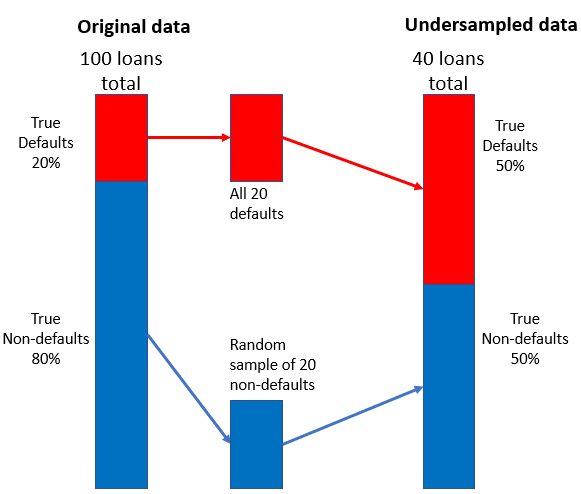Class imbalance in loan data
Credit Risk Modeling in Python

Michael Crabtree
Data Scientist, Ford Motor Company
Not enough defaults in the data
- The values of
loan_statusare the classes- Non-default:
0 - Default:
1
- Non-default:
y_train['loan_status'].value_counts()
| loan_status | Training Data Count | Percentage of Total |
|---|---|---|
| 0 | 13,798 | 78% |
| 1 | 3,877 | 22% |
Model loss function
- Gradient Boosted Trees in
xgboostuse a loss function of log-loss- The goal is to minimize this value
| True loan status | Predicted probability | Log Loss |
|---|---|---|
| 1 | 0.1 | 2.3 |
| 0 | 0.9 | 2.3 |
- An inaccurately predicted default has more negative financial impact
The cost of imbalance
- A false negative (default predicted as non-default) is much more costly
| Person | Loan Amount | Potential Profit | Predicted Status | Actual Status | Losses |
|---|---|---|---|---|---|
| A | $1,000 | $10 | Default | Non-Default | -$10 |
| B | $1,000 | $10 | Non-Default | Default | -$1,000 |
- Log-loss for the model is the same for both, our actual losses is not
Causes of imbalance
- Data problems
- Credit data was not sampled correctly
- Data storage problems
- Business processes:
- Measures already in place to not accept probable defaults
- Probable defaults are quickly sold to other firms
- Behavioral factors:
- Normally, people do not default on their loans
- The less often they default, the higher their credit rating
- Normally, people do not default on their loans
Dealing with class imbalance
- Several ways to deal with class imbalance in data
| Method | Pros | Cons |
|---|---|---|
| Gather more data | Increases number of defaults | Percentage of defaults may not change |
| Penalize models | Increases recall for defaults | Model requires more tuning and maintenance |
| Sample data differently | Least technical adjustment | Fewer defaults in data |
Undersampling strategy
- Combine smaller random sample of non-defaults with defaults
Combining the split data sets
- Test and training set must be put back together
- Create two new sets based on actual
loan_status
# Concat the training sets
X_y_train = pd.concat([X_train.reset_index(drop = True),
y_train.reset_index(drop = True)], axis = 1)
# Get the counts of defaults and non-defaults
count_nondefault, count_default = X_y_train['loan_status'].value_counts()
# Separate nondefaults and defaults
nondefaults = X_y_train[X_y_train['loan_status'] == 0]
defaults = X_y_train[X_y_train['loan_status'] == 1]
Undersampling the non-defaults
- Randomly sample data set of non-defaults
- Concatenate with data set of defaults
# Undersample the non-defaults using sample() in pandas
nondefaults_under = nondefaults.sample(count_default)
# Concat the undersampled non-defaults with the defaults
X_y_train_under = pd.concat([nondefaults_under.reset_index(drop = True),
defaults.reset_index(drop = True)], axis=0)
Let's practice!
Credit Risk Modeling in Python



